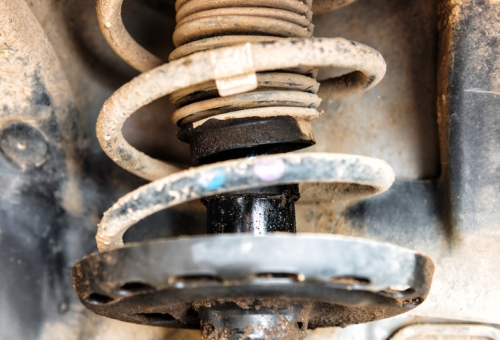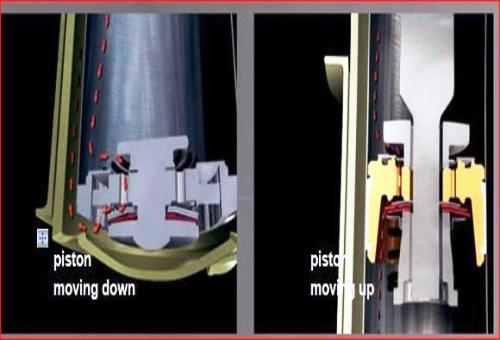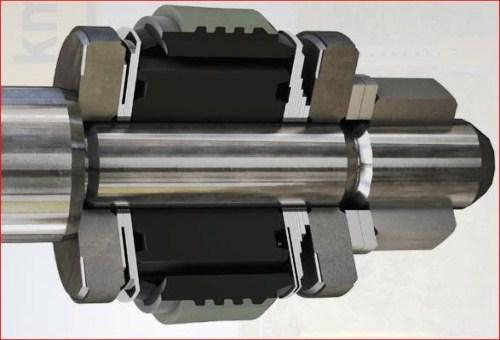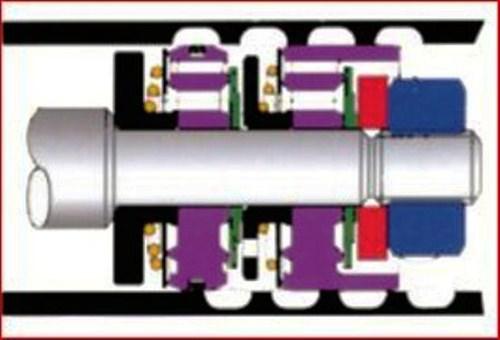
As technicians, we know and understand that shock absorbers are critical life-and-limb components of automotive suspension systems, but do we really know and understand how shock absorbers work, beyond knowing that shock damping is accomplished by oil passing through small orifices in a moving piston? In this article, we take a closer look at why shock absorbers are used, and how some of the engineering innovations in Monroe shock absorbers manage to balance vehicle stability with ride comfort, starting with this question-
Regardless of design differences between the various types of shock absorbers, all shock absorbers work in the same way and all have the same job, which is to convert the suspension systems’ movement into heat. This conversion process is the actual mechanism that stabilises, or damps out suspension oscillations that come about as the result of the compression and subsequent relaxation/extension of the suspension springs as the vehicle moves over uneven road surfaces.
Since shock absorbers do not support the weight of a vehicle, suspension oscillations will eventually reach uncontrollable rates unless the oscillations are damped out by the shock absorbers. However, shock absorbers are not created equal, and how well the compression and rebound rates of a particular shock absorber matches the compression and rebound rates of suspension springs is the single most important factor that determines the handling characteristics of a vehicle, which brings us to-
While the shock absorbers of 20 years ago did a decent job of damping out suspension oscillations, it used to be a fact that improved ride comfort could only be achieved at the expense of vehicle stability. However, modern shock absorbers, and particularly Monroe shock absorbers, have developed to the point where it is now possible to have superior ride comfort without sacrificing braking and steering responses, or vehicle stability as the result of insufficient damping.
Monroe’s approach to solving the ride comfort/vehicle stability equation involved some pretty out-of-the-box thinking, but in essence, the solution involved designing multistage valves to improve oil flow through the piston during both the compression and rebound strokes. Moreover, the actual operation of the improved valves is based on the velocity of the piston’s movement, which has the practical advantage that different piston velocities do not produce different damping rates. Here is how it works during the-
Compression stroke

During the compression stroke, the piston in the shock absorber is moving downwards, but unlike many other shock absorber designs, Monroe shock absorbers contain two compression valves. One is located in the piston; the other is located in the compression valve assembly, and it is this valve that controls shock damping during the compression stroke.
Here is what happens during the-
Rebound stroke
During the rebound stroke, the piston moves upward, and again unlike many other shock absorber designs, Monroe shock absorbers contain two rebound valves; one in the piston, and another in the compression valve assembly, and it is the rebound valve located in the piston that controls damping during the rebound stroke.
While the above might look like unnecessary duplication, it is exactly this duplication that makes it possible for each valve to have three distinct stages during both the compression and rebound strokes, with each valve supporting three distinctly different piston velocities, or more precisely, three different ranges of piston velocities. Here is how it works-
Bleed stage
During low speed driving there is not much body roll, and uneven road surfaces produce low piston velocities, such as might be achieved when you are compressing and extending a new shock absorber by hand. Since the piston is moving slowly, the oil in the shock absorber does not create much friction, and therefore, the oil passes through the valves in the shock absorber relatively easily. Note though that at very low piston velocities, oil cannot pass through either of the other two valving stages.
Blow off stage
Since there is more body roll at intermediate speeds and uneven road surfaces produce significantly higher piston velocities, more friction is generated as the oil moves through the valves. To compensate for the increased friction, both the rebound and compression valves operate in a so-called blow-off stage that allows oil to pass through a limited area of the valves without exerting a significant braking effect on the piston, which if it did, would produce a harsh and bumpy ride. Note that at intermediate piston velocities, oil cannot pass through the bleed or orifice stages.
Orifice stage
High road speeds produce very high piston velocities over uneven surfaces, so the orifice valve stage allows oil to pass through orifices in the piston in both the compression and rebound strokes. However, since a high rate of piston movement through the oil produces a lot of friction, allowing the oil through orifices means that the piston can move through the oil faster in both directions without sacrificing damping efficiency or ride comfort.
In practice then, the multi-stage valving means that Monroe shock absorbers are tuneable to suit specific applications, and that the levels of damping they provide are based on the piston velocity, and not so much on the amplitude of the suspension oscillation. Nonetheless, even Monroe shock absorbers have to deal with the phenomena of aeration and cavitation in the shock absorbers’ oil and gas charges. If aeration and cavitation are allowed to reach critical levels, the result is shock fade (reduced efficiency), the generation of excessive heat, noise, and premature failure of the shock absorber.
While aeration and cavitation are natural and expected consequences of normal shock absorber operation, Monroe has managed to engineer valves that greatly reduce both the occurrence and the effects of aeration and cavitation, but before we get to the specifics of these valves, we need to understand-
In simple terms, aeration is the process in which the gas in shock absorbers, typically nitrogen, is dissolved, mixed, or circulated through the oil in shock absorbers.
Theory holds that when a liquid is brought into contact with a gas than can dissolve into the liquid, the resulting mixture can be in any one of three forms; as foam, as a liquid-gas emulsion, or as a liquid-gas solution. If the gas is dissolved into the oil, gas bubbles form when the pressure of the solution falls below the liquid’s saturation pressure, which is described as the liquid’s ability to retain all the gas that is dissolved into it. It should be noted that the solubility of a gas into a liquid is determined by Henry’s Law, which states that the gas’ solubility is directly proportional to the absolute pressure immediately above surface of the liquid, and that the gas’ solubility decreases as the temperature of the liquid rises.
Nonetheless, regardless of the nature of the gas-liquid mix, all such mixtures can be described as a liquid that contains pockets of gas or vapour that have serious negative effects on the efficiency of shock absorbers. In practice, pockets of gas or vapour in the oil cause asymmetric force displacements (aka unpredictable behaviour) during the shock absorbers operation, and should therefore be minimised, which is where Monroe shock absorbers really shine with new proprietary technologies, the first being-

In simple terms, multi-tuned valves consist of stacks of spring-loaded discs on either side of the piston, with the diameter, thickness, and total number of discs in the stack determining the damping characteristics of any given shock absorber. Note that the disc stack incorporates both compression and rebound check valves that regulate the flow of oil trough the piston/disc stack combination.
The operation of multi-tuned valves can be divided into three modes, with each mode being determined by the speed at which the piston travels up or down the pressure tube. The first mode, also known as the “bleed stage” occurs under conditions such as high speed driving on a smooth road surface. Under these conditions there is relatively little piston movement, and whatever piston movements do occur, occur at low speeds, which translates into small damping forces.
Under these conditions, the disc stack remains closed, but oil is allowed to flow through the valve assembly through small openings between the discs, thus allowing for effective shock damping.
In the second mode, the so-called “blow-off” stage, piston movements fall into the intermediate range, such as might be expected when a vehicle is driven over speed humps or through potholes at low speeds. Under these conditions, the disc stack is forced partially open against the pressure of two spring loaded “fulcrum” discs, which allows more oil to move through the piston, thus providing increased damping without sacrificing ride comfort or vehicle stability.
The third mode is known as the “orifice stage”, and only comes into operation at very high piston speeds, such as might be expected to occur during violent braking or high-speed evasive manoeuvres when the weight of the vehicle is transferred very quickly, either from side to side, or from the back to the front. Under these conditions the disc stack is forced fully open, which allows for the rapid flow of oil through orifices in the valve assembly.
It should be noted that the rate of shock damping remains constant across all three modes of valve operation, regardless of the piston speed. All that changes is the volume of oil that passes through the piston/valve assembly during different valve operating modes. However, because the friction coefficient of the oil is directly related to the speed of the piston, the disc stack can be tuned to accommodate different oil flow rates at different times, thereby keeping the rate of shock damping constant, which brings us to-
It could be argued that most other shock absorbers do pretty much the same thing as Monroe shock absorbers and while this true, it is so only up to a point. The fact is that Monroe’s multi-tuned valve provides an almost infinite number of tuning options, all of which not only limit aeration and cavitation of the oil in a shock absorber, but also eliminates the often very harsh transition between “soft” and “hard” shock damping that is a common feature of most competing shock absorber designs.
In fact, Monroe’s multi-tuned valve makes it possible to design shock absorbers for very specific applications, merely by varying the number and thickness of the individual discs in the disc stack to suit the desired handling characteristics of a particular vehicle, which brings us to-
The advent of sport utility vehicles in which the suspension systems have to provide the comfort of a luxurious passenger vehicle while also providing superior shock damping characteristics in the off road environment, has until comparatively recently presented vehicle designers with a rather thorny problem.
The biggest problem involved the fact that conventional shock absorbers provide the same level of shock damping regardless of the position of the piston/valve assembly in the tube, which means that conventional shock absorbers cannot be tuned to compensate for a vehicles’ changing payload.
To address this issue, Monroe has developed a multi-stage shock absorber that has two pistons connected to a single rod. In practice, this means that different levels of shock damping are available within a single shock absorber, with each level of shock damping being dependent on the position of the pistons in the pressure tube.
As a practical matter, the pressure tube of a PST shock absorber contains a series of machined grooves or notches that allow the oil in the tube to flow around one piston, but never around both at the same time. Thus, if a vehicle is heavily laden, the bottom piston and its multistage valve operate in the bottom half of the pressure tube, but when the load is removed from the vehicle, the top piston and its multistage valve operate in the top half of the pressure tube.

In practice, the pistons and valves operate independently of each other, but since PST shock absorbers can be tuned to have different compression and rebound rates to achieve almost any conceivable shock damping curve, PST shock absorbers can be tuned to provide very specific ride characteristics to suit any application, while eliminating the transition between “soft” and “hard” shock damping, at the same time.
It should be borne in mind that even though Monroe shock absorbers incorporate some world-leading technologies, not even Monroe shock absorbers last forever. Therefore, it is crucially important to inspect the shock absorbers on your customers’ vehicles regularly, and to observe all industry standards and best practices when it comes to recommending, and replacing worn shock absorbers.